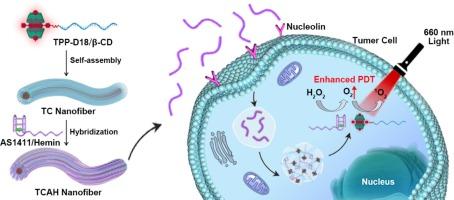Cyclodextrin-activated porphyrin-DNA nanofibers with AS1411/Hemin toehold for enhanced and targeted photodynamic therapy
IF 6.3
2区 化学
Q1 POLYMER SCIENCE
引用次数: 0
Abstract
Targeted photodynamic therapy is considered superior to conventional photodynamic therapy due to the enhanced uptake of photosensitizers by tumor cells. However, porphyrin-based photodynamic therapy is still limited due to the low hydrophilicity, poor biocompatibility and susceptibility to quenching of photosensitizers. Herein, we report cyclodextrin-activated porphyrin-DNA nanofibers with AS1411/Hemin toeholds, which enable targeted cancer cells recognition and catalytic oxygenation for enhanced photodynamic therapy. The nanofibers are formed through the self-assembly of the host–guest complex of cyclodextrin and porphyrin-DNA amphiphiles, and can be further functionalized on the surface with AS1411/Hemin. AS1411/Hemin can specifically target nucleolin-overexpressing cancer cells and catalyze conversion of excessive H2O2 into O2 within tumor cells, thereby alleviating tumor hypoxia and further cascaded enhancing PDT efficacy. These results suggest that the programmable and multifunctional nanofiber provided an effective nanoplatform for enhanced and targeted photodynamic therapy.

环糊精激活的卟啉-DNA 纳米纤维,具有 AS1411/Hemin 趾持,可用于增强和靶向光动力疗法
由于肿瘤细胞对光敏剂的吸收能力增强,靶向光动力疗法被认为优于传统光动力疗法。然而,由于光敏剂亲水性低、生物相容性差且易淬灭,基于卟啉的光动力疗法仍然受到限制。在此,我们报告了具有 AS1411/Hemin 趾持的环糊精活化卟啉-DNA 纳米纤维,它能识别靶向癌细胞并催化氧合,从而增强光动力疗法。这种纳米纤维是通过环糊精和卟啉-DNA 两性化合物的主客复合物的自组装形成的,并可通过 AS1411/Hemin 在其表面进一步功能化。AS1411/Hemin 可特异性靶向核素表达过高的癌细胞,催化肿瘤细胞内过多的 H2O2 转化为 O2,从而缓解肿瘤缺氧,并进一步级联提高光动力疗法的疗效。这些结果表明,可编程多功能纳米纤维为增强和靶向光动力疗法提供了一个有效的纳米平台。
本文章由计算机程序翻译,如有差异,请以英文原文为准。
求助全文
约1分钟内获得全文
求助全文
来源期刊

European Polymer Journal
化学-高分子科学
CiteScore
9.90
自引率
10.00%
发文量
691
审稿时长
23 days
期刊介绍:
European Polymer Journal is dedicated to publishing work on fundamental and applied polymer chemistry and macromolecular materials. The journal covers all aspects of polymer synthesis, including polymerization mechanisms and chemical functional transformations, with a focus on novel polymers and the relationships between molecular structure and polymer properties. In addition, we welcome submissions on bio-based or renewable polymers, stimuli-responsive systems and polymer bio-hybrids. European Polymer Journal also publishes research on the biomedical application of polymers, including drug delivery and regenerative medicine. The main scope is covered but not limited to the following core research areas:
Polymer synthesis and functionalization
• Novel synthetic routes for polymerization, functional modification, controlled/living polymerization and precision polymers.
Stimuli-responsive polymers
• Including shape memory and self-healing polymers.
Supramolecular polymers and self-assembly
• Molecular recognition and higher order polymer structures.
Renewable and sustainable polymers
• Bio-based, biodegradable and anti-microbial polymers and polymeric bio-nanocomposites.
Polymers at interfaces and surfaces
• Chemistry and engineering of surfaces with biological relevance, including patterning, antifouling polymers and polymers for membrane applications.
Biomedical applications and nanomedicine
• Polymers for regenerative medicine, drug delivery molecular release and gene therapy
The scope of European Polymer Journal no longer includes Polymer Physics.
文献相关原料
公司名称
产品信息
阿拉丁
2,2′-Azinobis-(3-ethylbenzthiazoline-6-sulphonate) (ABTS2?)
阿拉丁
Hemin
 求助内容:
求助内容: 应助结果提醒方式:
应助结果提醒方式:


